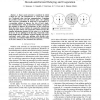Free Online Productivity Tools
i2Speak
i2Symbol
i2OCR
iTex2Img
iWeb2Print
iWeb2Shot
i2Type
iPdf2Split
iPdf2Merge
i2Bopomofo
i2Arabic
i2Style
i2Image
i2PDF
iLatex2Rtf
Sci2ools
CORR
2007
Springer
2007
Springer
Capacity of Linear Two-hop Mesh Networks with Rate Splitting, Decode-and-forward Relaying and Cooperation
— A linear mesh network is considered in which a single user per cell communicates to a local base station via a dedicated relay (two-hop communication). Exploiting the possibly relevant inter-cell channel gains, rate splitting with successive cancellation in both hops is investigated as a promising solution to improve the rate of basic singlerate communications. Then, an alternative solution is proposed that attempts to improve the performance of the second hop (from the relays to base stations) by cooperative transmission among the relay stations. The cooperative scheme leverages the common information obtained by the relays as a by-product of the use of rate splitting in the first hop. Numerical results bring insight into the conditions (network topology and power constraints) under which rate splitting, with possible relay cooperation, is beneficial. Multi-cell processing (joint decoding at the base stations) is also considered for reference.
Base Stations | CORR 2007 | Education | Rate Splitting | Relay |
| Added | 13 Dec 2010 |
| Updated | 13 Dec 2010 |
| Type | Journal |
| Year | 2007 |
| Where | CORR |
| Authors | Osvaldo Simeone, Oren Somekh, Yeheskel Bar-Ness, H. Vincent Poor, Shlomo Shamai |
Comments (0)

